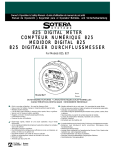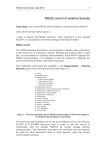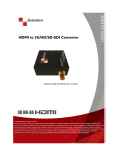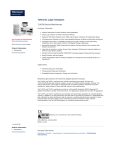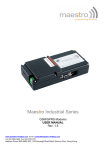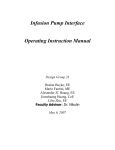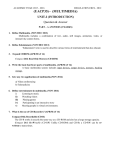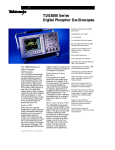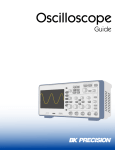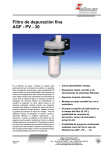Download Microphone lab
Transcript
BME 194: Applied Circuits Lab 2: Electret Microphones Kevin Karplus January 12, 2013 1 Design Goal For this lab, you will • characterize the DC behavior of an electret microphone, using the Arduino to automate the measurement, • design a simple circuit to bias the microphone appropriately to have an output that is centered at 1v, • observe the waveform of the microphone on the oscilloscope, and • design a very simple high-pass (DC-blocking) filter to convert the microphone output from being centered at 2.5v to being centered at 0v, using just resistors and capacitors. Much of this lab is familiarization with the oscilloscope (DC and AC coupling, input scaling, X1/X10 probes, time base, triggering, . . . ) and with the Arduino data logger. 2 Background Electret microphone An electret microphone consists of a permanently charged capacitor (an “electret”) connected to the gate of a field-effect transistor. One plate of the capacitor is a diaphragm, moved by the changes in air pressure that make up sound. Because the charge on the electret is constant, but the capacitance changes with the separation between plates of the capacitor, the voltage across the capacitor changes with the separation: V (t) = Q/C(t) . The small change in voltage is converted to a change in the saturation current of the field-effect transistor (FET), which can be measured externally. We will look at field-effect transistors more carefully in a later lab: for this lab we are mainly interested in looking at the electret microphone as a simple sensor, but some of the FET behavior will appear in the DC characterization of the microphone. Read http://en.wikipedia.org/wiki/Electret and http://en.wikipedia.org/wiki/Electret microphone Oscilloscope An oscilloscope is a device for visualizing a time-varying voltage. There are two main types: analog and digital. http://en.wikipedia.org/wiki/Oscilloscope 1 The analog oscilloscopes use a cathode-ray tube, which shoots an electron beam at a phosphorcoated screen to make a bright dot. The electron beam is deflected horizontally by a sawtooth waveform, so that the spot moves repeatedly across the screen from left to right at a constant speed. The beam is deflected vertically by the input voltage, so that what appears on the screen is the voltage as a function of time. The digital oscilloscopes record the input voltage for a chunk of time, then display it on the screen. The recorded data can be manipulated in various ways that are not feasible with the analog scope, and the data can be saved on a computer for further analysis. It is now possible to get devices that serve as the front-end of a digital oscilloscope, using a laptop or tablet computer for the display. These are currently less sophisticated than dedicated oscilloscopes, but considerably cheaper for similar levels of capability. Traditionally, oscilloscopes have a display that is 10 “divisions” wide and 8 “divisions” high. The oscilloscopes have controls for setting the scaling of the inputs and of the time base, in terms of how many volts or seconds there are per division. The inputs usually also have a choice of DC-coupled or AC-coupled input. http://en.wikipedia.org/wiki/Capacitive coupling http://en.wikipedia.org/wiki/Direct coupling Both analog and digital scopes have “trigger” conditions, which determine when a sweep across the scope display starts. These trigger conditions can be based on any of the inputs to the scope (there is often an additional input to the scope available only for triggering). On analog scopes, the trigger is usually a voltage level and whether the input signal is rising or falling as it crosses that voltage level. Digital scopes may have the ability to do more complicated triggering logic. Because digital scopes have memory, they allow you to see what happened before the trigger, as well as afterward. The triggers can be done once (single triggering), producing one sweep across the screen. On digital scopes, this gives you a record of a one-time event that can be carefully analyzed, but on an analog scope, the fluorescence quickly fades, unless the trace is captured photographically. The triggers can also be done in “normal” mode, where each occurrence of the trigger starts a new trace. If you have a repetitive input signal, this allows the analog display to show the same portion of the signal repeatedly, giving a stable image (like looking at a rotating object with a stroboscope). Finally, there is usually an “auto” mode that starts a new trace without waiting for a trigger signal, which allows you to see the input without having to set proper trigger conditions. Generally, you use the “auto” mode to look at the signal and choose appropriate trigger conditions. For more information about triggering look at http://hobbyprojects.com/oscilloscope tutorial/oscilloscope trigger controls.html 3 Pre-lab assignment Read about electret microphones, as cited above. Read the data sheet for the CMA-4544PF-W electret microphone we’ll be using for this lab. Read about oscilloscopes in general, as cited above. Read about the controls for the oscilloscopes in the lab: Kikusui COS5041 analog scope http://www.kikusui.co.jp/kiku manuals/C/COS5040 5041 E.PDF Tektronix TDS3052 2-channel digital storage scope. Somewhat surprisingly, Tektronix hides their user manual behind a login requirement, making it relatively inaccessible to students or purchasers of used equipment. Given how extremely confusing 2 their control panels are without a manual, this is extremely short-sighted of them—if students have bad experiences learning to use their equipment, who will specify the equipment later? I found a copy at http://www.cs.washington.edu/education/courses/cse466/07wi/labs/l2/Oscope/TDS3000Manual.pdf The analog scopes are easier to learn to use and will be sufficient for this lab, though the digital scopes offer considerably more capability if you can figure out the controls. Despite the inventory claims on the BELS web pages, there appear to be more digital scopes than analog scopes in the lab, so you’ll probably have to learn to use them at least minimally—you can’t be sure that the simpler analog scopes will be available. Read how to use the function generators in the lab: Agilent 33120A. You won’t need most of the capability of those function generators (which are really overkill for a beginning circuits course), just how to generate a sine wave of known frequency, which is covered in pages 19–21 of the User’s Guide: http://www.home.agilent.com/upload/cmc upload/All/6C0633120A USERSGUIDE ENGLISH.pdf Prepare gnuplot scripts for plotting current versus voltage and equivalent resistance versus voltage, including fitting different models. You’ll probably have to tweak these scripts once you get real data, but you’ll want to have a usable basis to start from, rather than spending all your lab time reading gnuplot documentation. 4 Parts, tools, and equipment needed Parts for this lab from kit: • CUI inc CMA-4544PF-W electret microphone http://www.digikey.com/product-detail/en/CMA-4544PF-W/102-1721-ND/1869981 • resistors • 10kΩ trimpot • breadboard • loudspeaker Parts students need to provide on their own: • Arduino board. Drivers should be installed on lab computers for Uno, Uno R3, Duemilanove, and Leonardo versions of the Arduino board. Arduino Mega boards not tested yet, but should work on your own computer if the drivers are installed. Arduino Due not supported by the Data Logger. • USB cable for board. Tools for this lab: • wire cutters • wire strippers • small screwdriver for trimpot Equipment in lab: • power supply (for providing power to microphone) 3 Figure 1: Back of the electret microphone. In this orientation, the lower terminal is “Terminal 2”, which should be connected to ground, and the upper terminal is “Terminal 1”, which should be connected via a series resistor to the positive voltage source (or terminal 2 to the positive power rail, and terminal 1 via a series resistor to ground). • multimeter (for measuring current and voltage) • oscilloscope (for observing signal) • function generator (for producing a sound signal for mic) 5 Procedures DC characterization with multimeter The first part of the lab is to measure the DC current through the microphone for various DC voltages across it. With the equipment in the lab, this is most easily done by hooking up a multimeter configured as an ammeter in series with the mic, and powering the pair from the bench power supply. Connecting clip leads to the mic can be difficult, but the mic plugs into the breadboard easily, allowing wires or double-ended header pins to be used as probe points. Be sure to get the polarity right, as shown in Figure 1. Measure the current at several different voltages (say 1–10 volts in steps of 1 volt). Note that the data sheet specifies a maximum voltage for the microphone. Don’t exceed it. Record the voltages and currents in a table and try to fit the I-vs-V curve with various functions. If your measurements are all for voltages over 1v, you should see fairly constant current. DC characterization with Arduino Measuring with the multimeter and recording the data by hand in a lab notebook or by typing it into a file is tedious, and so relatively few data points well be taken. This makes it easy to miss important phenomena, so let’s automate the measurement. The goal is to use the Data Logger from C:\ProgramFiles\DataLogger\ or http://bitbucket.org/abe k/arduino-data-logger/get/default.tar.bz2 to record numbers from which you can derive either an I-vs-V curve or an R-vs-V curve (where the resistance here is the DC resistance R = V /I not the dynamic resistance dV dI ). There are some limitations of the Arduino analog-to-digital converter that are important for this lab: 4 ñÿðï ùþ ùòñý ÿø þýüûú ÷öõ ôöóþ ôöóø ÿþ þýüûú ùòñþ îíì Figure 2: Schematic for testing the the DC characteristics of the microphone. The voltage source is the bench power supply. Schematic drawn using http://www.circuitlab.com/editor/ • There are only 6 channels that can be recorded on (for Uno and other ATmega328-based boards—some of the newer boards have more pins that can be used as analog inputs). • The highest voltage allowed is 5v and the lowest is 0v. • The resolution is only 10 bits (1024 steps). • The steps seem to be more uniformly spaced at the low end of the range than the high end (so differences at the high end are less accurate than differences at the low end). • The external reference voltage AREF must be at least 0.5v (this is not in the data sheet, but when I tried lower AREF voltages, the reading was always 1023), and no more than 5v. • Readings are not simultaneous, but the analog-to-digital converter is quickly switched from one input to another. It takes at least 104µs for each conversion. For slowly changing signals, this skewing of the inputs in time doesn’t matter much, but for fast-changing signals it can make a big difference. • The Arduino has limited memory size for queuing recordings and will drop data points if its queue is full. The serial line rate of 115200 baud means that you can’t sample inputs more frequently than once per millisecond with one analog channel, adding about 0.5msec for each additional analog channel. (The Leonardo, using a different USB protocol may be able to get a little more speed out of the USB channel, to the point where the Python program on the host computer becomes a more important bottleneck.) The Arduino can only record voltages (as well as digital values and timestamps), so we need to convert the current through the microphone into a voltage that we can measure with the Arduino. The circuit in Figure 2 provides one way to do this. The bench power supply provides a known voltage that is used as the AREF reference voltage of the Arduino’s analog-to-digital converter, the 18-turn trimmer potentiometer (trimpot) allows us to present a lower voltage to the microphone plus 10kΩ resistor that act as a voltage divider. We can use two analog inputs of the Arduino to record the voltage across the resistor (which we can convert to a current through the resistor, 5 since we know the resistance) and the voltage across both the microphone and the resistor. If we subtract VA1 from VA0 we get the voltage across the microphone. Since you are connecting an external voltage reference to AREF, be sure to specify the “external” option in the data logger configuration pane. Your files will be much easier to work with if you have the data logger compute the voltages of A0 and A1 for you. Also, remember to document in the notes what A0 and A1 are connected to, so that you can interpret the files later. For two or three different settings of AREF (say 0.55v, 1.7v, and 5v), record a series of measurements (say every 100ms) as you adjust the trimpot from one end of its range to the other. Each different AREF setting will need a different output file for the data, since the DataLogger puts metadata in the file about the settings used. [Note: you can do this part of the lab at home without the bench power supply, by using the 5v supply from the Arduino board, but you need to measure what voltage that is with a multimeter— it depends on the power being delivered through the USB port, which can fluctuate quite a bit and still be within the USB spec. The bench supply is a much more reliable DC signal. Getting lower AREF voltages than 5v at the input to the trimpot using just the Arduino may require using another trimpot as a voltage divider to divide down the 5V supply. ] Write a gnuplot script to plot the data as I-vs-V points and as R-vs-V points. I found it useful to plot each file separately (so the points are color-coded by which file they cam from), but to make a larger file by concatenating all the separate files for fitting models to the data. Plotting with log scales on both axes makes the data look simpler and easier to come up with models for. Using a linear scale for voltage may hide the low-voltage behavior. Here are four models to try fitting: • linear (resistance) model: I = V /RL . You may want to fit RL for just the lower voltages across the microphone. • saturation (current source) model: I = Isat . You may want to fit the saturation current Isat for just the higher voltages across the microphone. q q 2 + (V /I 2 2 2 • blended linear and saturation model: R(V ) = RL sat ) or I(V ) = V / RL + (V /Isat ) . This makes a smooth transition from the linear model to the saturation model, with the limV →0 R(V ) = RL and limV →∞ R(V ) = Isat /V . This model is similar to a standard model for FET behavior. • power-law model. The saturation current, as I measured it, was not constant, q but increased 2 + (V p /I 2 slightly as voltage increased. I modeled this with a power law: R(V ) = RL sat ) q 2 + (V p /I 2 or I(V ) = V / RL sat ) . If p = 1, this is the same as the previous model, but with p < 1, the current goes up with voltage even in the saturation region. The current-versus-voltage plots for the four models are shown in Figures 3 and 4. When I tried this lab, I got a very good fit with the last model, except at very low voltages and currents, where the quantization errors of the Arduino made measurement unreliable. Microphone to oscilloscope You will be converting the current output of the electret microphone to a voltage output by putting the mic in series with a load resistor connected to a +5 v power supply (like a voltage divider, but with the microphone between the output and ground). Using your measurements or the formula you found for the I-vs-V curve, compute what resistance this load resistor should have to get a 1v 6 Current vs. voltage for electret mic Current through mic [microA] 100 10 1 linear model saturation current blended model power law in saturation region 0.1 0.001 0.01 0.1 Voltage across mic [V] 1 10 Figure 3: Current-versus-voltage plot for the electret mic. The log scale for current makes the lowvoltage behavior clearer. For this figure, I’ve deliberately suppressed the data and the parameters I got, to give the flavor of the models. Your plots should, of course, include the data and you should use “sprintf” in the titles of the plotted curves to print the parameters of the models. Current vs. voltage for electret mic 250 Current through mic [microA] 200 150 100 50 linear model saturation current blended model power law in saturation region 0 0.001 0.01 0.1 Voltage across mic [V] 1 10 Figure 4: Current-versus-voltage plot for the electret mic. The linear scale for current makes the high-voltage behavior clearer. Again, I’ve suppressed the data and the parameters. 7 ñðï ÿþýüûú ïþüìö ïþëî îí ùýø÷öõøöôóò÷ Figure 5: Schematic for the microphone, the load resistor, and the DC-blocking capacitor. You will need to fill in the values used. I’ve used a standard nFET symbol for the electret microphone (rather than square box I used in Figure 2), because CircuitLab does not have a symbol for a microphone. Schematic drawn using http://www.circuitlab.com/editor/ output voltage. Choose the closest standard resistance value from your collection of resistors, and measure the DC voltage you actually get. Now hook up the oscilloscope probe to the output of the microphone and try to view the output of the microphone as a time-varying signal. You can whistle or talk into the mic or provide some other sound source. It may be easiest to learn to use the scope if you have a known input signal. One way to get that is to hook up the function generator to a loudspeaker to put out a sine wave of known frequency, say between 50Hz and 5kHz. Try using both AC coupling and DC coupling for the scope input, and see what happens if you change the triggering conditions. What is the amplitude of the AC output of the microphone? The AC amplitude is half the peak-to-peak voltage—that is, it is the maximum voltage minus the minimum voltage, divided by 2. Note that this amplitude will depend on how loud your sound input is. Add a DC-blocking capacitor to the microphone as shown in Figure 5 and connect scope probes to both Vout and VAC . Use the oscilloscope to compare the output of the microphone at the two points at different frequencies of input. Use the multimeter(s) to measure the RMS AC voltage at the two points for different frequencies (say 5Hz, 10Hz, 20Hz, 50Hz, 100Hz, . . . , 50kHz). Plot the ratio RM S(VAC )/RM S(Vout ) as a function of frequency. don’t move your speaker or microphone around during these tests, as you don’t want to change the relationship between the two. Your hands and body can act as important reflectors of sound also, so keep them well away from the mic and speaker during this test. Note: the effect should be different depending on what size capacitor you use, particularly at the lower frequencies. Try a few different sizes, from 470µF down to 100pF. 6 Demo and writeup Demo the oscilloscope outputs to a TA or instructor, showing that you know how to adjust the time base, the input scaling, and the triggering. On the Monday after the lab, turn in a writeup describing what you did. Remember that the instructors are not your audience—a bioengineer who has not read the assignment is. Provide at least 8 • a purpose of the report (the problem you are solving or the design information you are providing), • the I-vs-V or R-vs-V curves for the electret microphone (which electret microphone?), • a schematic of the tested circuit, • a plot of the ratio of the RMS voltage after the DC-blocking capacitor to the RMS voltage before the DC-blocking capacitor as a function of frequency. 7 Design Hints When trying to come up with a function for the I-vs-V curve, look at the plot with different ways of scaling the x and y coordinates. To choose a suitable initial DC-blocking capacitor value for testing, try to block frequencies below about 50 Hz (much higher than one would normally want to use). Use the pull-up resistor 1 you chose as the resistance and the RC time constant RC = 2πf for a cutoff frequency f to compute the capacitance. If that works, try a capacitor about 50 times larger, to get a 1Hz cutoff. We’ll look at RC filtering in more detail later in the quarter. 9










